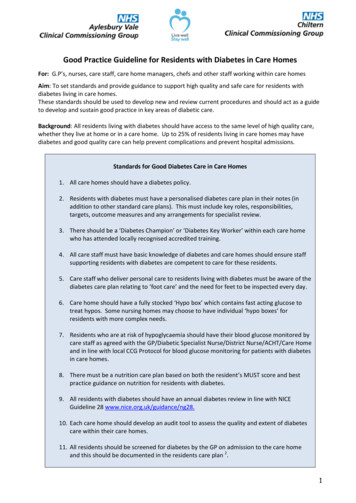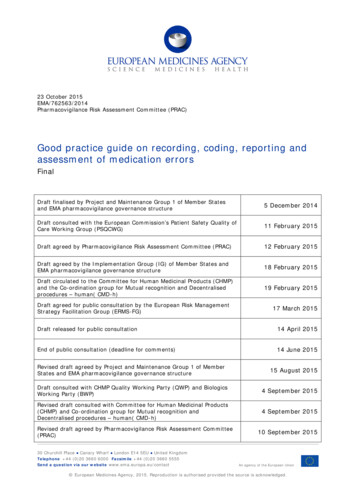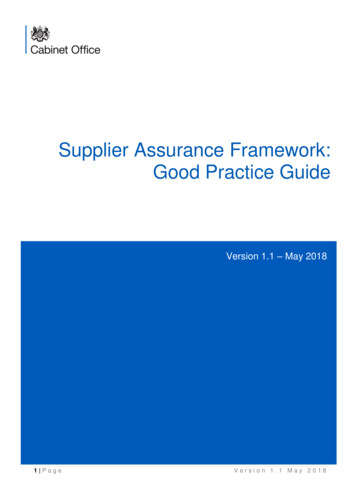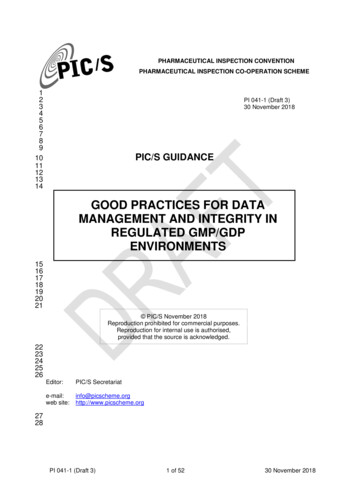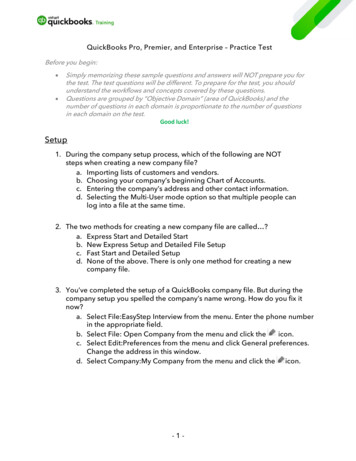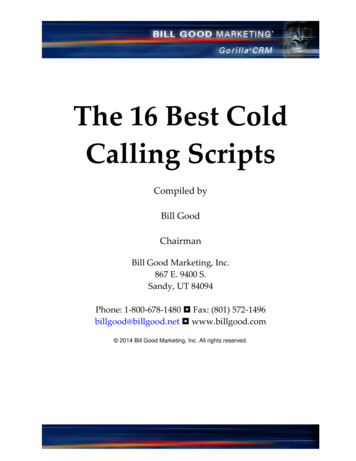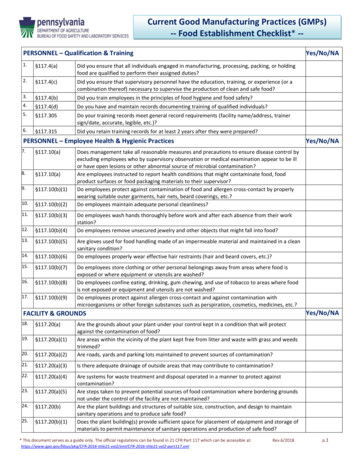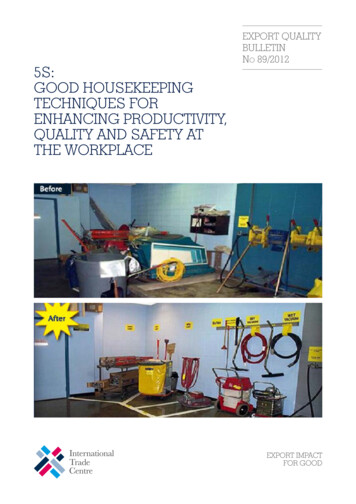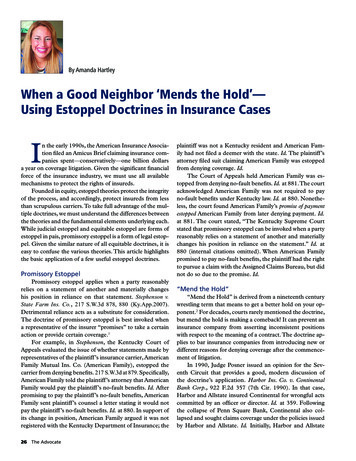
Transcription
By Amanda HartleyWhen a Good Neighbor ‘Mends the Hold’—Using Estoppel Doctrines in Insurance CasesIn the early 1990s, the American Insurance Association filed an Amicus Brief claiming insurance companies spent—conservatively—one billion dollarsa year on coverage litigation. Given the significant financialforce of the insurance industry, we must use all availablemechanisms to protect the rights of insureds.Founded in equity, estoppel theories protect the integrityof the process, and accordingly, protect insureds from lessthan scrupulous carriers. To take full advantage of the multiple doctrines, we must understand the differences betweenthe theories and the fundamental elements underlying each.While judicial estoppel and equitable estoppel are forms ofestoppel in pais, promissory estoppel is a form of legal estoppel. Given the similar nature of all equitable doctrines, it iseasy to confuse the various theories. This article highlightsthe basic application of a few useful estoppel doctrines.Promissory EstoppelPromissory estoppel applies when a party reasonablyrelies on a statement of another and materially changeshis position in reliance on that statement. Stephenson v.State Farm Ins. Co., 217 S.W.3d 878, 880 (Ky.App.2007).Detrimental reliance acts as a substitute for consideration.The doctrine of promissory estoppel is best invoked whena representative of the insurer “promises” to take a certainaction or provide certain coverage.1For example, in Stephenson, the Kentucky Court ofAppeals evaluated the issue of whether statements made byrepresentatives of the plaintiff’s insurance carrier, AmericanFamily Mutual Ins. Co. (American Family), estopped thecarrier from denying benefits. 217 S.W.3d at 879. Specifically,American Family told the plaintiff’s attorney that AmericanFamily would pay the plaintiff’s no-fault benefits. Id. Afterpromising to pay the plaintiff’s no-fault benefits, AmericanFamily sent plaintiff’s counsel a letter stating it would notpay the plaintiff’s no-fault benefits. Id. at 880. In support ofits change in position, American Family argued it was notregistered with the Kentucky Department of Insurance; the26 The Advocateplaintiff was not a Kentucky resident and American Family had not filed a deemer with the state. Id. The plaintiff’sattorney filed suit claiming American Family was estoppedfrom denying coverage. Id.The Court of Appeals held American Family was estopped from denying no-fault benefits. Id. at 881. The courtacknowledged American Family was not required to payno-fault benefits under Kentucky law. Id. at 880. Nonetheless, the court found American Family’s promise of paymentestopped American Family from later denying payment. Id.at 881. The court stated, “The Kentucky Supreme Courtstated that promissory estoppel can be invoked when a partyreasonably relies on a statement of another and materiallychanges his position in reliance on the statement.” Id. at880 (internal citations omitted). When American Familypromised to pay no-fault benefits, the plaintiff had the rightto pursue a claim with the Assigned Claims Bureau, but didnot do so due to the promise. Id.“Mend the Hold”“Mend the Hold” is derived from a nineteenth centurywrestling term that means to get a better hold on your opponent.2 For decades, courts rarely mentioned the doctrine,but mend the hold is making a comeback! It can prevent aninsurance company from asserting inconsistent positionswith respect to the meaning of a contract. The doctrine applies to bar insurance companies from introducing new ordifferent reasons for denying coverage after the commencement of litigation.In 1990, Judge Posner issued an opinion for the Seventh Circuit that provides a good, modern discussion ofthe doctrine’s application. Harbor Ins. Co. v. ContinentalBank Corp., 922 F.2d 357 (7th Cir. 1990). In that case,Harbor and Allstate insured Continental for wrongful actscommitted by an officer or director. Id. at 359. Followingthe collapse of Penn Square Bank, Continental also collapsed and sought claims coverage under the policies issuedby Harbor and Allstate. Id. Initially, Harbor and Allstate
denied coverage claiming the actionsof the directors were so egregiousthat–even if their conduct fit within thegood-faith provision of Continental’scharter—federal and state law wouldforbid indemnifying Continental’sdirectors. Continental, consequently,settled two securities cases for 17.5million and filed a claim against Harborand Allstate seeking reimbursement.Id. At that point, Harbor and Allstateabandoned the position regarding thedirector’s conduct altogether. Instead,Harbor and Allstate denied coveragearguing Continental settled the claimsprematurely. Id. at 360.Writing for the court, Judge Posnerexplained Railway Co. v. McCarthy, 96U.S. 258 (1877) first defined mend thehold in specific terms. Id. The RailwayCo. Court held,Where a party gives a reasonfor his conduct and decisiontouching anything involved ina controversy, he cannot, afterlitigation has begun, change hisground, and put his conductupon another and differentconsideration. He is not permitted thus to mend his hold.Id. (internal quotations omitted)Judge Posner went on to explainthat courts from around the countryapplied mend the hold “as a substantivedoctrine especially applicable to insurancecompanies that change their reason forrefusing to pay a claim.” Id. at 363.3Judicial EstoppelAs Kentucky acknowledged decades ago, “the rule of law to the effect that a party to litigation will notbe permitted to assume inconsistent orcontradictory positions with respect tothe same matter in the same or a successive series of suits is well groundedupon familiar principles of estoppel.”Rowe v. Shepherd, 283 S.W.2d 188, 190(Ky. 1955). The rule of law to which theRowe Court refers is judicial estoppel.Judicial estoppel prevents a party fromasserting contradictory positions inContinued on following pageCall us if your clients need care and help after the settlementWe can buypartial paymentsto preserve more ofthe structure.For more information or to refer to a case, please contact Sheila Thomsenat Sheila.Thomsen@StrategicCapital.com or 1-866-241-6111March/April 201727
EstoppelContinued from previous pagesuccessive litigation. Hisle v. LexingtonFayette Urban County Government, 258S.W.3d 422 (Ky.App. 2008). When applying the doctrine of judicial estoppel,courts consider:1. Whether the party’s later position isclearly inconsistent with its earlierposition;2. Whether the party succeeded inpersuading a court to accept theearlier position; and3. Whether the party seeking to assert an inconsistent position wouldderive an unfair advantage or impose an unfair detriment on theopposing party. Hisle, 258 S.W.3dat 434-5.In an unreported opinion, the Kentucky Court of Appeals invoked thedoctrine of judicial estoppel to preventan insurance company from assertinginconsistent positions regarding insurance coverage. Countryway InsuranceCompany v. Oakes, 2010 WL 2787915(Ky.App. 2010). In Countryway, theplaintiff was injured while driving anautomobile owned by her mother.Id. at 1. The plaintiff settled with thetortfeasor for the underlying liabilitypolicy limits. Id. As such, the plaintiffproceeded against her underinsuredmotorist (UIM) carrier, Countryway.Id. However, Cincinnati Ins. Co. insured the vehicle and provided UIMcoverage. Id.Throughout the underlying litigation, Countryway agreed it was responsible for damages on a pro rata basis. Id.at 2. Following judgment, the plaintiffsettled with Cincinnati Ins. Co. for itspro rata share of her damages. Countryway, however, decided to change itsposition.On appeal, Countryway again28 The Advocateargued it was only responsible for excess coverage. The Kentucky Court ofAppeals, however, refused to considerthe merits of Countryway’s argument.Rather, the court held Countryway wasjudicially estopped from arguing itspolicy only provided excess coverage.Id. Even though the issue of judicialestoppel was not raised at the trialcourt level, the Kentucky Court ofAppeals invoked the doctrine to estopCountryway from changing positions.Particularly, the court found Countryway “consistently agreed and arguedbefore the court that its policy providedpro rata coverage.” Id. Countrywayfurther “stated that it agreed that it wasresponsible for a pro rata share of thedamages awarded to [the plaintiff].” Id.As such, Countryway could not arguefor the first time in support of a posttrial brief it was responsible for onlyexcess coverage. Id. Given the facts, thecourt held, “under the circumstances,Countryway is judicially estopped fromasserting an inconsistent position.” Id.As to the second factor listedabove, the Countryway Court held, “thesuccess in persuading the court requirement does not mean the party againstwhom the judicial estoppel doctrineis to be invoked must have prevailedon the merits . . . judicial acceptancemeans only that the first court has adopted the position urged by the party.”Id. quoting Colston Inv. Co., at 763.Equitable EstoppelEquitable estoppel operates topreclude a party from asserting aposition inconsistent with a positionpreviously taken by that party. Weinbergv. Gharai, 338 S.W.3d 307 (Ky. App.2011). The doctrine absolutely precludes the assertion of the inconsistentposition—which can prevent insurersfrom asserting (otherwise valid) termsand coverage limitations in insurancepolicies. Estoppel “offsets misleadingconduct, acts, or representations whichhave induced a person to rely thereonto change his position to his detriment.”Howard v. Motorists Mut. Ins. Co., 955S.W.2d 525, 527 (Ky.1997). Establishing equitable estoppel involves thefollowing elements:1. Conduct, including acts, languageand silence, amounting to a representation or concealment of material facts2. The estopped party is aware ofthese facts3. These facts are unknown to theother party4. The estopped party must act withthe intention or expectation hisconduct will be acted upon, and5. The other party in fact relied uponthis conduct to his detriment.Id.As to the fourth element, a showing of actual intent to mislead is notnecessary. Id. at 528. The court stated,“Requiring the party seeking to invoke estoppel to show actual intentto mislead, though, asks too much.”Id. Rather, “The fact that the partyto be estopped should have known orhad reason to believe or expect [hisactions] would have such an effect isenough.” Id.In Harris v. Jackson, 192 S.W.3d297 (Ky. 2006), the insurance carrierhired an attorney to defend the tortfeasor. The insurance carrier was not aparty. During litigation of the claim, thetortfeasor died, but the attorney did notdisclose the death to opposing counsel.Id. at 299. Opposing counsel missed theone year statute of limitations to revivethe claim. Id. The Kentucky SupremeCourt held the actions of the attorneyestopped 1) the insurance carrier and2) the estate from relying on the statuteof limitations. Id. at 307.In support of the finding, theKentucky Supreme Court noted, “one
may not stand by and make no objection to a proceeding in court with theanticipation that if it results favorablythe benefits will be accepted, but that ifit results unfavorably objections will bemade.” Id. at 307. By failing to informopposing counsel and continuing toparticipate in the litigation as thoughnothing changed, the attorney’s actionsmisled and deceived the plaintiff. Id.at 305. As the real party in interest,the attorney acted as an agent for theinsurance carrier (even though the carrier was not a “party” to the litigation).Id. at 303. Due to the attorney’s failureto disclose, the carrier and the estatewere estopped from asserting a statuteof limitations defense. Id. at 307.Similarly, in Howard (cited above),the Kentucky Supreme Court held theacceptance of premiums estopped theinsurance carrier from denying coverage.Howard, 955 S.W.2d at 529. In Howard,the insurer cashed the insured’s check foran overdue premium and retained themoney for two weeks without informingthe insured of the conditional natureof acceptance and the right to refusecoverage. Id. at 528. After holding themoney, the insurer (Motorist Mutual)returned a check to the insured. Id. Onthe exact same day Motorist returnedthe premium, the insured was in a collision. Id. at 526. Before the collision—on two occasions—Motorist acceptedlate premiums and provided retroactivecoverage. Id. at 527. The court, therefore, found Motorist’s prior actionsindicated it would extend coverage. Id.Moreover, the insured assumed she hadinsurance because Motorist cashed hercheck. Id. at 528. The insured furthertestified, 1) she would not have drivenif she knew she did not have insurance,2) asked for a refund of the premium,and 3) sought insurance elsewhere. Id.Instead, the insured continued to drivebelieving she had insurance. Id. Thecourt determined the insured relied toher detriment. Finding the elements ofequitable estoppel satisfied, the courtdetermined Motorist was precludedfrom denying coverage. Id. at 529.Similarly, the Sixth Circuit recentlyheld an insurer’s statements indicatingit would pay 75,000 under an insurance policy estopped the insurer fromlater denying it was responsible forpaying 75,000 in coverage. DemolitionContractors, Inc. v. Westchester SurplusLines Ins. Co., 381 Fed.Appx. 526 (6thCir. 2010).In yet another insurance context,Kentucky courts frequently apply thedoctrine of equitable estoppel to prevent an insurance carrier from denyingcoverage to an insured in the absenceof a reservation of rights. If an insurerfails to properly reserve its rights before assuming the insured’s defense,equitable estoppel can preclude theinsurer from denying coverage. SeeAmerican Casualty Co. of Reading, Pa.v. Shely, 234 S.W.2d 303 (Ky. 1950);Hood v. Coldway Carriers Inc., Ky.App.,405 S.W.2d 672 (1965), and UniversalUnderwriters Ins. Co. v.The Travelers Ins.Co., Ky.App., 451 S.W.2d 616 (1970).Likewise, in the case of claimants—unrepresented by counsel—the doctrineof equitable estoppel can prevent adefendant from relying upon the statuteof limitations if there is “some act orconduct which in point of fact misleadsor deceives the plaintiff and obstructsor prevents him from instituting [orprotecting] his suit while he may doso.” Harris, 192 S.W.3d at 307. Settlement offers and promises to settle canestop a defendant from relying uponthe statute of limitations in numerouscontexts. See as examples Montgomeryv. Carter County,Tennessee, 226 F.3d 758(6th Cir. 2000); Wilburn v. Pepsi-ColaBottling Company of St. Louis, 492 F.2d1288 (8th Cir. 1974); and AgriculturalIns. Co. of Watertown, NY v. Iglehart,386 P.2d 145 (Ok. 1963); Economy Fire& Casualty Company v. GAB BusinessServices, Inc., 507 N.E.2d 896 (Ill.App.1987); Lyden v. Goldberg, 490 P.2d 181(Or. 1971), and Shinabarger v. UnitedAircraft Corp., 381 F.2d 808 (2nd Cir.1967).Continued on following pageDo you love the ListServer but dislike the interruptions?You can receive messages from the KJA Member Listserver in a DIGESTformat—one message daily with each message in the body of the email. Ifyou love the listserver but want fewer daily emails, just call the KJA office.We’ll fix it.(502) 339-8890March/April 201729
EstoppelContinued from previous page4.Though Kentucky has not examined a recent case directly on point andolder cases employ different reasoning,the policy and spirit behind the UCSPA and general equitable principlesdemonstrate Kentucky law is directlyin line with the cases cited above.Kentucky law recognizes insurancecompanies enjoy a disproportionatelylarge bargaining position and wealth ofinformation not enjoyed by the averageunrepresented, injured party.5.6.Other TheoriesIn addition to the foregoing, thereare a few other estoppel theories tokeep in mind.1. Plaintiffs can utilize the doctrineof collateral estoppel (issue preclusion) offensively to estop aninsurance carrier from re-litigatingissues that it previously, unsuccessfully litigated against a differentplaintiff. Issue preclusion requiresthat at least one party to be boundin the second case was a party inthe first case; the issue in the second case is the same as the issue inthe first case; the issue was actuallylitigated; the issue was actuallydecided in that action; and thedecision on the issue in the prioraction was necessary to the court’sjudgment.2. Representations to state regulators or administrative agenciesby the insurance industry and/orinsurance companies can estopcarriers from asserting inconsistentpositions, sometimes referred to as“regulatory estoppel.”3. Quasi-estoppel (not regularlyidentified by name in Kentucky)can apply when a party, litigatingwith knowledge of the facts, takes30 The Advocate7.8.a position inconsistent with thelitigant’s former position—to thedisadvantage of another.Administrative collateral estoppelcan prevent an insurance companyfrom re-litigating an administrativedecision in court.Fraud on the court applies to assertions in litigation that misleada court. The doctrine is most frequently invoked when an attorneyis involved in misleading the court,and it can serve as an exception tocollateral estoppel.A judicial admission is a formalstatement regarding a material factthat is deliberate, clear, unequivocal and made during a judicialproceeding. A judicial admissionis conclusive as to that fact.Evidentiary admissions (as opposed to judicial admissions) areextra-judicial admissions that arisefrom a litigant’s relevant statement. Unlike a judicial admission—which is conclusive as to the factadmitted—evidentiary admissionsmay be controverted or explainedby the litigant.Res judicata (claim preclusion)prohibits relitigation of claimsthat were litigated or could havebeen litigated between the sameparties in prior actions. Related tocollateral estoppel, the doctrine ofres judicata requires an identity ofthe parties, an identity of the causesof action, and a decision on themerits.9. Though not speaking in terms of aspecific doctrine, some courts find“bad faith” can lead to coverage byestoppel even if there is no coverageunder an insurance policy.— Amanda L. Hartley is an associateat DeCamillis & Mattingly, PLLC inLouisville.1 For the purposes of the various estoppel theories outlined herein, an insurer(and any attorney hired by the insurer)unquestionably acts as agent for theinsured during the course of negotiations with a third party. Harris v. Jackson,192 S.W.3d 297 (Ky. 2006). Not onlyis the relationship well recognized byKentucky law, it is established by theinsurance contract itself.2 See Harbor Ins. Co. v. Continental BankCorp., 922 F.2d 357 (7th Cir. 1990).3 There is some dispute regarding mendthe hold’s ability to prevent inconsistentpositions pre- and post-litigation. Generally, the doctrine should (and oftendoes) apply to prevent one positionpre-litigation and a different positionpost-litigation.Office Space for LeaseApproximately 1700 squarefeet of office space is available forlease. Three offices with great window views. 201 West Short Street,penthouse, Lexington, Ky.For more information, please contact Austin Mehr or Debbie Duncanat 859-225-3731.
an insurance company from asserting inconsistent positions regarding insur-ance coverage. Countryway Insurance Company v. Oakes, 2010 WL 2787915 (Ky.App. 2010). In Countryway, the plaintiff was injured while driving an automobile owned by her mother. Id. at 1. The plaintiff settled with the tortfeasor for the underlying liability policy limits. Id.
